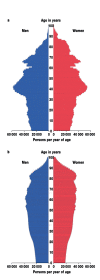The projected burden of stroke in the German federal state of Hesse up to the year 2050
- PMID: 19626195
- PMCID: PMC2696913
- DOI: 10.3238/arztebl.2008.0467
The projected burden of stroke in the German federal state of Hesse up to the year 2050
Abstract
Introduction: The aging of the population in Germany will lead to an increased number of stroke patients, but at present there are hardly any concrete estimates of how many stroke patients can be expected in the future.
Methods: This study provides estimates of future numbers of stroke patients in the German federal state of Hesse up to the year 2050. The calculations are based on data obtained from a state-wide quality assurance program for stroke, as well as on demographic data provided by the Statistical Office of the state of Hesse.
Results: The annual number of stroke patients in Hesse is projected to increase steadily from 20 846 in 2005 to more than 35 000 in 2050. By the year 2050, the majority of stroke patients will be 75 years or older. The proportion of severely handicapped stroke patients will increase above average.
Discussion: The projected increase in the number of stroke patients will require substantial changes in health care services unless the incidence of stroke falls in the future, e.g. as the result of improved primary prevention. The development of strategies to prevent stroke in elderly persons should be given a high priority from a health policy perspective.
Keywords: demographic change; epidemiology; health services research; projection; stroke.
Figures





References
-
- Eisenmenger M, Pötzsch O, Sommer B. Bevölkerung Deutschlands bis 2050 - 11. Koordinierte Bevölkerungsvorausberechnung. Statistisches Bundesamt. http://www.destatis.de.
-
- Lopez AD, Mathers CD, Ezzati M, Jamison DT, Murray CJ. Global and regional burden of disease and risk factors 2001: systematic analysis of population health data. Lancet. 2006;367:1747–1757. - PubMed
-
- Rosamond W, Flegal K, Friday G, et al. Heart disease and stroke statistics -2007 update: a report from the american heart association statistics committee and stroke statistics subcommittee. Circulation. 2007;115:69–171. - PubMed
-
- Kolominsky-Rabas PL, Heuschmann PU, Marschall D, et al. Lifetime cost of ischemic stroke in Germany: results and national projections from a population-based stroke registry: the Erlangen stroke project. Stroke. 2006;37:1179–1183. - PubMed
-
- Struijs JN, van Genugten ML, Evers SM, Ament AJ, Baan CA, van den Bos GA. Modeling the future burden of stroke in the Netherlands: impact of aging, smoking, and hypertension. Stroke. 2005;36:1648–1655. - PubMed
LinkOut - more resources
Full Text Sources

